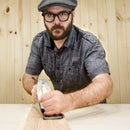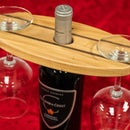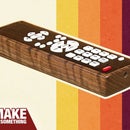Introduction: How to Flock a Box Drawer
I show you a technique called flocking. This is commonly used in lining the drawers of boxes and cases. It leaves a soft velvety feel and adds a touch of class to your projects. The fibers used in the process are very small and lightweight so I highly suggest proper air filtration and a dusk mask. I flock all the drawers of my bandsaw boxes and sometimes I will flock the cavity the drawer slides into. I really like the look and feel of flocking fibers.
Step 1: Step 1: Masking
First I'll mask off the outside edges to protect it from any unwanted drips or mishaps.
Step 2: Step 2: Load Up
Now you'll load the mini-flocker with the fibers. Use way more than you'll need. What doesn't get used can be saved. Put the tube back together and set it aside.
Step 3: Step 3: Brush on Adhesive
The adhesive is pretty thick. You'll want to brush it on the areas to be flocked. I like to work quickly because I don't want it to dry before adding the fibers.
Step 4: Step 4: Flocking Fibers
I like to use storage containers when flocking because all the fibers that don't make it onto the adhesive can be collected and reused. And now start pumping the fibers right on the wet adhesive. The forced air will shoot it into all the nooks and crannies. Be sure to do this as close to your air filter as possible to prevent the fibers from getting airborne. Also, make sure you are wearing your dust mask. This is something you definitely don't want to breath in. You want to make sure you don't see any wet spots and when you're done you can knock out all the loose fibers.
Step 5: Step 5: Remove Masking Tape
You can now remove the tape and let it dry for 24 hours.
Step 6: Step 6: Blow It Out
Once it's dry you can take an air compressor or shop vac and blow out any loose fibers.











